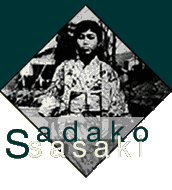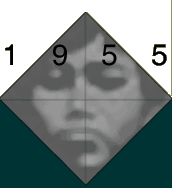
|
|
In
Japan, legend says that a person who makes a thousand origami
cranes will live a long life. The legend took on new meaning
in 1955, when Sadako Sasaki (shown above and below), a twelve-year-old
girl who was exposed to radiation during the bombing of
Hiroshima, contracted leukemia. While in the hospital, she
tried to fold 1,000 cranes but died before she could finish.
Sadako's statue now stands in Hiroshima's Peace Memorial
Park, where it is decorated every year with thousands of
origami cranes, folded by children from around the world,
as a symbol of peace.
Click
here
for a larger image of Sadako
Sasaki.
Click
here
to visit www.sadako.com
|
|

|
 he art of paper
folding, like the art of papermaking, began in China, but it spread
to Japan by the sixth century A.D. Over the centuries, it became an
integral part of Japanese culture. Paper butterflies symbolized the
bride and groom at weddings; folding a thousand paper cranes became
a traditional way to ensure a long and healthy life. Animals were an
especially popular theme, as "folders" developed more and
more ingenious ways to make a little diamond of folded paper sprout
legs or wings—and even to make it float, hop, or fly. Even so,
Japanese origami evolved very slowly. According to American origami
expert Peter Engel, Japanese folders invented about 150 traditional
origami figures in a millennium of folding.
he art of paper
folding, like the art of papermaking, began in China, but it spread
to Japan by the sixth century A.D. Over the centuries, it became an
integral part of Japanese culture. Paper butterflies symbolized the
bride and groom at weddings; folding a thousand paper cranes became
a traditional way to ensure a long and healthy life. Animals were an
especially popular theme, as "folders" developed more and
more ingenious ways to make a little diamond of folded paper sprout
legs or wings—and even to make it float, hop, or fly. Even so,
Japanese origami evolved very slowly. According to American origami
expert Peter Engel, Japanese folders invented about 150 traditional
origami figures in a millennium of folding.
But in the last twenty-five
years, new materials, new methods, and new ideas have transformed the
traditional world of origami on both sides of the Pacific. The simple
and stylized animals of the past, which relied as much on the viewer's
imagination as on the folder's skill, have been joined by bugs and beasts
bristling with anatomically correct legs and teeth. Some folders are
exploring new subject matter, such as elaborate cuckoo clocks or working
Swiss army knives. Others venture into the abstract world of mathematics,
assembling spectacular interlocking polyhedra or tile mosaics, or defying
straight-line geometry to sculpt graceful curves. As origamists reach
out to new materials (silk, transparency film, bubblegum wrappers) and
new design tools (yes, the computer age has arrived), perhaps only two
things remain taboo to serious folders: scissors and glue.
"Cutting is the least
aesthetic folding operation of all because it destroys the wholeness
of the paper," writes Jeremy Shafer, the dynamic origamist/juggler/unicyclist
who leads San Francisco's origami club, the Bay Area Rapid Folders (BARF).
"I like to think of the origami paper as sacred, and from this
viewpoint, I see the cutting of origami as sacrilege." Or, as Eric
Eros, another BARF member, says, "Scissors make it too easy."
The new origami is anything but easy. Shafer has designed a model of
the Star Trek spaceship Enterprise that takes seventy-two diagrams and
eleven pages to explain. It took a month for Shafer to design, and the
average folder could expect to take a week to make it. Origami designer
Robert Lang routinely stretches the limits of belief with critters like
his computer-designed lobster, which comes fully equipped with eight
legs, a tail, a head, claws, and antennae.
To origamists, their burgeoning
art form is like music. Most folders begin as performers, bringing to
life the work of the composers, but a restless few feel the urge to
explore further. As Shafer says, "We have to come up with ideas
that extend the bounds of origami, not the mounds of paper." These
few—Americans like Shafer, Lang, John Montroll, and contemporary
Japanese folders including Toshikazu Kawasaki and Jun Maekawa—vie
to create spectacular new compositions. Yet the art is large enough
to allow each designer his own style and philosophy. Just as no musician
will ever confuse a Beethoven symphony with a Mozart, no origamist will
ever confuse a Shafer model with a Lang. Here is a sampler of the creations
of modern origamists, ranging from the gorgeous to the whimsical. Just
remember, every one of these (with one exception) began as a single
sheet of material, and can be folded without cutting or gluing.
|




